This was one of the questions that was debated recently at the Snow Industry Management Association’s (SIMA) 2020 Symposium held virtually on August 26-28, 2020.
It is not a stretch to say that there are times when government officials at the local or regional levels push through decisions that may catch individuals or businesses by surprise. Thus, when participants at SIMA got involved in a discussion about salt use and its environmental impact on wetlands and aquifers, the question about possible governmental action opened the subject to consider how that might play out realistically and in practical terms.
The issue was framed as followed:
- For years, the inherent environmental concern regarding the use of granular salt has garnered the attention of scientists and environmental activists, with the need to find ways to control its use.
- Research indicates that salt is a potential hazard to lakes, streams, wetlands, underground aquifers, vegetation, and wildlife.
- Salt is currently the product of choice to keep road and parking lot surfaces safe for vehicles and pedestrians.
- Roads and parking lots must stay open for use.
- Therefore, commercial contractors need to think proactively to develop practical solutions to best reduce salt use, especially in those areas with the greatest risk of environmental harm, while keeping roads and parking lots open and safe.
No one believed that there was any alternative to salt that would, in the near term, completely replace it. However, experts agree that without the industry taking the lead, environmental activists lacking a true appreciation of the economics of the business could possibly step in and pass ordinances that would adversely impact large numbers of companies that provide this very essential service.
Alternatives to Granular Salt
Liquid saltwater brine is often cited as a highly touted alternative to rock salt because of the theoretical amount of acreage that can be covered with brine versus granular salt. Unfortunately, conditions and timing are critical to brine’s effectiveness and the unpredictability of storms and temperatures make this a very imperfect strategy in actual practice. Several companies commented that they rushed into buying expensive brine equipment some years ago without fully understanding the practical challenges associated with this type of application. They now find themselves returning to rock salt. More than one company mentioned that their brine equipment will “gather dust” over the coming winter (and beyond).

Performance challenges are not the only issue, however. Brine de-icing brews may not only pollute streams and lake water but can also prematurely rust vehicles and erode concrete road structures. In 2017, Vermont introduced a bill that would have banned the use of brine mixes, but it was not passed.
There are several potential environmentally attractive alternatives to brine, including pickle juice, barley or potato residue from distilleries, and cheese brine. Volcanic ash, sand and wood chips have also been tried alone or in a salt brew. Temperature has much to do with how effective these various combinations hold up, with some of these combinations failing in frigid cold and in some cases leading to a worse ice problem. Beet juice, for example, was one of the appealing sounding solutions that gained considerable initial press. However, to work effectively, it still had to be mixed with some form of chloride, and there were complaints about staining of pavement, shoes, and clothing. Additionally, studies found that the sugar content in beet juice contributed to high algae growth in lakes, which in some instances was perceived as more environmentally detrimental than the amount of salt it was replacing.
Sectional technology can “reduce the amount of road salt applied by as much as 40%.
In Canada, when you get much outside of the larger population areas in Ontario or Quebec, you start to see less dependency on salt, primarily because it does not work effectively in sub-zero temperatures. In Edmonton, for example, the preferred material is sand, although it is actually a mixture of salt and sand called “pickle”. The salt is added to keep the sand from freezing.
Improving Operator Training Goes a Long Way
In addition to promoting the use of brine to replace granular salt, municipalities are also focusing on improving wasteful or unnecessary practices that are only making the problem worse.
Ted Butler, Corporate Sales Director of Canada Heavy Equipment College in Cambridge Ontario has been dealing with the issue of salt management for decades and finds that much can be improved by simply focusing on operator training. “Proper operator training can reduce salt use immensely, generally by half or more. For our Public Works clients, we currently offer sixteen courses in our Winter Training Program alone.” There are several case studies on the www.canada.ca website that highlight initiatives to reduce road salt with many references to operator best practices.
John Allin, founding member of SIMA and perhaps the most recognized expert on the Snow and Ice Management Industry, agrees. “Education is key. Operator training is one of the best investments anyone can make, not only to reduce liability expenses but to save significantly on salt use as well. However, much of the waste in salt comes from a lack of patience. Salt must be allowed to do its job and variables like moisture and the sun allow the salt to do what it is intended to do. This is where the client needs to be educated as well so that the impulse to simply throw down more salt is better managed.”
Going “Sectional”
Replacing road salt completely will be a daunting task, both economically and politically. It is used throughout North America, Europe, Japan, China, and even South America. It is a common material available in great supply and there are no industrialized countries seeking to eliminate it completely, despite the well-publicized environmental issues involved. In all likelihood, the greatest progress that will be made in the next decade will be on efforts to reduce rather than eliminate its use.
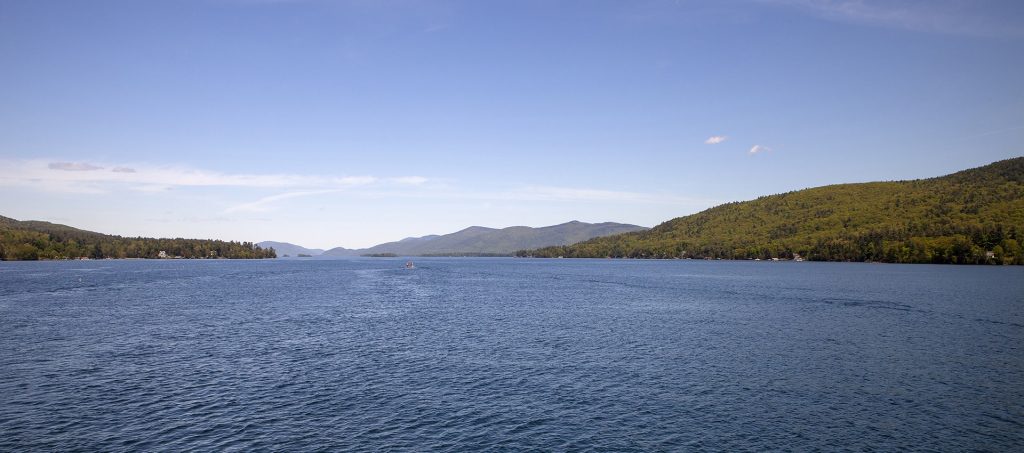
One possible scenario is already being witnessed in upstate New York. Some municipalities have initiated “sectional” or “segmented edge” plow programs in which contractors as well as municipalities are encouraged to use contouring plows and pushers on their equipment.
Biologist Rick Relyea is the director of the Darrin Fresh Water Institute and the Jefferson Project at Lake George at the Rensselaer Polytechnic Institute in Troy, New York, which has been studying the effects of road salt since 2014. Lake George is a deep, clear 32-mile-long body of water in northern New York. Relyea and colleagues monitor the lake and conduct experiments in artificial habitats to determine the effects of chloride and other components of salts on aquatic life.
…many commercial snow contractors are able to recoup their investment in “Sectional” technology in their first season of use simply based on salt savings.
Relyea says that to offset the impact road salt is having on Lake George, local governments have been adopting plows with sectioned edges that contour to pavement anomalies, thus clearing more snow. In 2015, the S.A.V.E. (Stop Aquatic Invasives from Entering) Lake George Partnership discovered that the lake’s salt levels tripled over the last generation. This resulted in a cry for road salt reductions and specifically the use of sectioned plows or pushers for nearby municipalities.
According to a statement from S.A.V.E., segmented edge technology can “reduce the amount of road salt applied by as much as 40%.” At the time, the Lake George Park Commission made it known that it could help municipalities apply for grants to help offset the costs of these specialty pushers and plows. In December 2016, the FUND for Lake George, in conjunction with S.A.V.E, delivered a matching grant to the Town of Lake George for new sectional equipment.
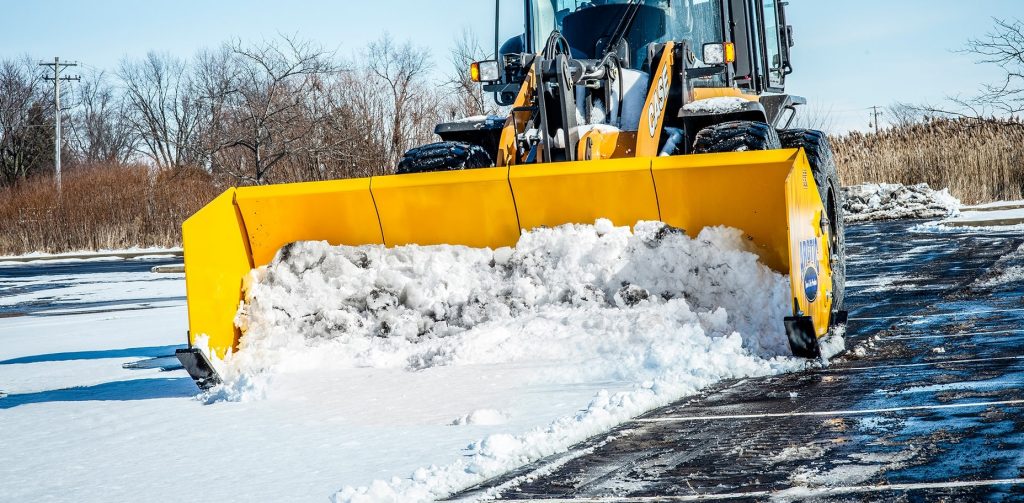
New York is not the only state in which sectional technology is being heralded for its ability to reduce salt’s impact on the environment. It was recently announced that New Hampshire implemented a salt reduction program within its stormwater permitting program with the state’s Department of Transportation which involved investing in sectional snow equipment.
“The business case for practical and significant reduction of salt applications requires a continuous improvement approach and policies that hold the salting process accountable through the use of private performance contracts or public ordinances that follow Sustainable Winter Management (SWiM®) guidelines”, according to Phill Sexton with WIT Advisers who administer the SWiM® program and certifications (https://witadvisers.com/swim). “Program guidelines being followed by municipal ordinances and private properties in Lake George, and many other regions throughout North America, include the required use of segmented plow technology as a primary tool for significantly reducing salt use.”
How “Going Sectional” Will Affect Contractors’ Bottom Line
This is a topic of which there were many SIMA participants who had some familiarity with the economics of using sectional pushers and plows. While they are more expensive than conventional blades, most users consider that the benefits more than justify the higher cost.
When it comes to “Sectional” technology, the dominant company in this space is Arctic Snow and Ice Products, Inc., headquartered in Frankfort, IL. It was the one brand consistently referenced by the Symposium members and as such was given center stage for illustration purposes. “I think it is safe to say that most experts consider the Arctic Sectional Sno-Pusher™ far and away the best snow pusher in the industry in terms of performance, safety, survivability and overall value,” said John Allin.
By all accounts, the Arctic story is well known to the entire industry and especially SIMA members, as it was one of its founding sponsors. The company is broadly recognized as the only major manufacturer that is also a major service provider, a fact that is well appreciated by other snow contractors. According to Allin, “The industry has long recognized the Arctic team for having a deep understanding of the brutal demands of their industry, perhaps more so than any other manufacturer. The fact that they are also such a large service contractor helps explain their reputation for building a thoroughly tested product that performs expertly in the field under the toughest conditions.”

Arctic invented the highly patented Sectional Sno-Pusher in 1995 for their own service fleet and used and refined it for 11 years before launching it to the public in 2006, where it has consistently grown market share each year. Nearly all units produced since 1995 are still in use thanks to an all-modular design that enables every sectional pusher and plow to be maintained in near new condition.
One of the key strengths of the Arctic Sectional when compared to standard designs is its ability to cleanly scrape a surface on the first pass, because its independent sections effectively contour to surfaces in ways that a single piece blade cannot. As a result, customers claim that, in addition to saving considerable time, they also save an average of 50% on salt use. This is a key economic driver for their purchase, as many can recoup their investment in one season of use.
Selecting the Right Tool for the Job
Recently, some other manufacturers introduced their own spring-based segmented edge variations that, in average to ideal conditions, are effective in contouring to lots and roadways, reducing the use of salt by as much as 40%. Their best use is on municipal salt trucks that handle light snow and general cleanup efforts on open roadways. However, construction equipment like wheel loaders are the workhorses for heavy wet snow, ice and hardpacked snow, as well as all parking lots, the typical landscape for commercial contractors. This is where spring designs often fail.
By their very nature, spring designs cannot drop much below grade to get into areas where snow may gather and are incapable of applying down pressure to cutting edges to clear ice or hardpack since they are designed to release under pressure. They also show a fragile side when encountering larger obstacles, since they are attached metal to metal. These are all issues to consider both in terms of performance and survivability.
Conversely, the Arctic design uses a patented polyurethane mounting block system instead of springs, allowing the “Sectional” to clear large obstacles up to eight inches in height, get into depressions up to eight inches deep, withstand collisions without major damage, and apply as little or as much down pressure as necessary (up to 30,000 pounds) directly to the cutting edge to clear ice and hardpack snow easily — something no other design can do. The “polyblocks” are also the primary reason that Arctic’s safety record is what it is. The inexpensive and easily replaced polyblocks are designed to act as the key line of protection in any event that would otherwise cause catastrophic loss to the equipment or seriously injure the operator.
Economically, its ability to seamlessly float over obstacles saves on equipment, property, and operators. Its unique ability to perform sidewalk cleaning simultaneously also saves time and money as well. Lastly, contractors exclusively employing Arctic Sectionals in their fleet have reportedly been able to lower their insurance premiums, based on documented evidence of reduced property and injury claims.
In Conclusion
For commercial snow contractors, it may only be a matter of time before environmental advocacy threatens those firms hanging onto older pusher technology that encourages greater salt use. Thus, the decision to swap one’s conventional pusher fleet for sectional alternatives may or may not be voluntary. In the meantime, it may be advisable for snow contractors to introduce sectional technology to their own operations if they have not already. Given the economic benefits that many are already realizing with this equipment, this may be a win-win for both environmentalists and commercial snow contractors alike. ■

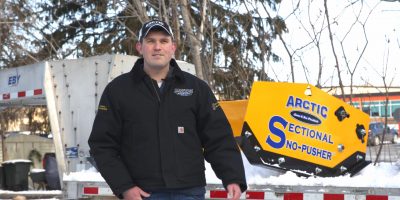


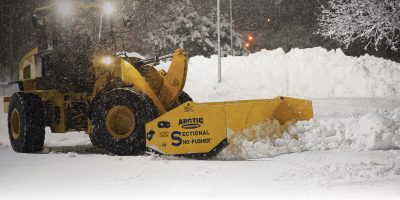

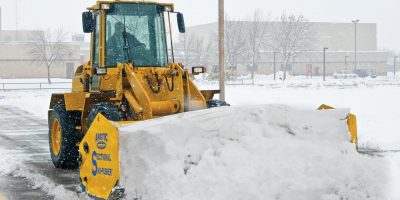
Comments